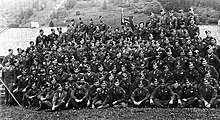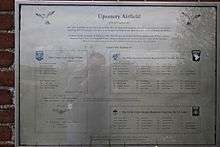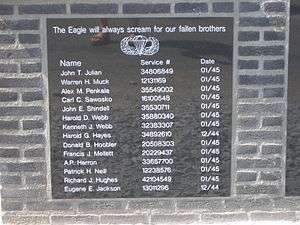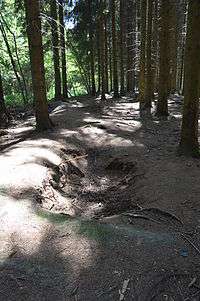E Company, 506th Infantry Regiment (United States)
E Company, 2nd Battalion of the 506th Parachute Infantry Regiment of the 101st Airborne Division, the "Screaming Eagles,” is a company in the United States Army. The experiences of its members during World War II are the subject of the HBO miniseries Band of Brothers based on the book of the same name by historian Stephen Ambrose.
| E Company, 2nd Battalion, 506th Parachute Infantry Regiment, 101st Airborne Division (Air Assault) | |
|---|---|
.svg.png) | |
| Active |
|
| Country | |
| Branch | |
| Type | Infantry company |
| Role | Air Assault Forces |
| Nickname(s) | "Easy Company" |
| Motto(s) | "Currahee" (We Stand Alone) |
| March | Blood on the Risers |
| Engagements | World War II: * Operation Overlord * Operation Market Garden * Battle of the Bulge * Western Allied invasion of Germany |
| Commanders | |
| Colonel of the Regiment | |
| Notable commanders | |

History
The 506th PIR was an experimental airborne regiment created in 1942 to jump from C-47 transport airplanes into hostile territory.
E Company was established at Camp Toccoa, Georgia. Before attending paratrooper training, the unit's troops performed the standard battle drills and physical training that comes with being in the parachute infantry. One of the exercises was running Currahee, a large, steep hill whose trail ran "three miles up, three miles down". E Company, while training at Toccoa, was under the command of Herbert Sobel, who was known for his extreme strictness.
Also as part of their physical training, the members of E Company performed formation runs in three-four column running groups. This innovative type of training was adopted by the Army in the 1960s.
As a result of the harsh physical training Easy Company underwent while at Camp Toccoa, Georgia, the unit was in such impeccable physical condition that they were able to skip the physical training portion of Jump School.
One of its commanders, Major Richard Winters, said E Company originally "included three rifle platoons and a headquarters section. Each platoon contained three twelve-man rifle squads and a six-man mortar team squad. Easy also had one machine gun attached to each of its rifle squads, and a 60mm mortar in each mortar team."[1]
Missions
Operation Overlord (D-Day)
For Operation Overlord, E Company's mission was to capture the entrances to and clear any obstacles around "Causeway 2", a pre-selected route off Utah Beach for the Allied forces landing from the sea a few hours later. The company departed from Upottery airbase in Devon, England, and dropped over the Cotentin Peninsula of Normandy, France in the early hours of the morning of 6 June 1944.

After assembling on the ground, the men of E Company disabled a battery of four German heavy guns on D-Day that threatened forces coming along Causeway 2.[2] The town of Carentan was crucial for American soldiers to capture because it would link Omaha and Utah beaches together, providing access for armor and equipment. The Germans were aware of its strategic importance and had established significant defences. In one of Donald Malarkey's articles he stated that Lieutenant Winters made him mortar sergeant of second platoon. E Company, along with Dog and Fox companies, were walking down the road to Carentan when they came to an intersection and one or two German machine gun teams began firing on them. Mortars and tanks soon joined the fight.
The American soldiers all jumped into ditches for cover. Winters saw this and as Malarkey states, Winters "got hotter than I've ever seen him." It was a fast attack, at the end of which Malarkey states that he could hear moans and groans of wounded soldiers and occasional gun shots. Also at the end of the battle Winters was slightly wounded in his lower right leg by a ricocheting bullet fragment. The Germans mounted a counterattack, but 2nd battalion held onto Carentan. By the time the company was pulled off the line, they had taken 65 casualties including 22 killed in action—17 of whom, including their commanding officer and first sergeant, were killed on D-day when their plane was shot down.[3]
Eindhoven, the Netherlands
As part of the ultimately unsuccessful Operation Market Garden, E Company was assigned to support the British forces around Eindhoven by defending the roads and bridges that would allow British armored divisions to advance into Arnhem and force a crossing over the major bridge across the Rhine in September 1944.
E Company landed on its designated drop zone in the Sonsche Forest, northwest of Son, and marched down the road into Son behind the 2nd Battalion's other two companies. On reaching the Son Bridge they were met by enemy harassing fire whilst the bridge was destroyed by the Germans. After the Regiment's engineers constructed a makeshift crossing, E and the rest of the 506th moved out for Eindhoven. These events were omitted from the Band of Brothers series, with E having been portrayed as landing in the Netherlands and then marching into Eindhoven to join up with the British Army advancing from the south.
On 19 September, the company departed for Helmond accompanied by six Cromwell tanks of the British 11th Armoured Division.[4] Their advance was halted by the German 107th Panzer Brigade outside Nuenen and they were forced to retreat to Tongelre.[4] During the days following the link up, E Company successfully defended the towns of Veghel and Uden until XXX Corps infantry took up the task of defending the area. As Market Garden progressed, the company and the rest of the 101st joined the 82nd Airborne on "the island" north of Nijmegen.
At the conclusion of Market Garden, the company relieved the British 43rd (Wessex) Infantry Division in Zetten.[5] On 5 October 1944, 1st platoon fought in the battle of "the island" that lay between the Lower Rhine and the Waal river. Along with a platoon from Fox Company and support from the Royal Artillery, they routed two Waffen-SS companies on 5 October 1944.[6] Colonel Sink issued a general order citing the company's 1st platoon for gallantry in action, describing their attack a "daring act and skillful maneuver against a numerically superior force".[7]
E Company was involved in the rescue of over 100 British troops trapped outside Arnhem. Operation Pegasus was a military operation carried out on the Lower Rhine near the village of Renkum, close to Arnhem in the Netherlands. Overnight on 22–23 October 1944, the Allies evacuated a large group of men trapped in German occupied territory who had been in hiding since the Battle of Arnhem. On the south bank of a Dutch river, Canadian engineers and a patrol of E Company observed the signal and immediately launched their boats, but the British were some 500-800m upriver of the crossing point.
Upon reaching the north bank E Company established a small perimeter while men headed east to locate the evaders.[8] The men quickly moved downstream and in the next 90 minutes all of them were evacuated, with the exception of a Russian who was captured by the Germans. The Germans opened fire sporadically and some mortar rounds fell near the crossing, but the fire was inaccurate. Once on the other side the escapees were led to a farmhouse for refreshments, before being driven to Nijmegen where Dobie had arranged a party and champagne. The men were later flown back to the UK, rejoining the men who had escaped in Operation Berlin. Nine members of E company were killed in action in Holland with at least 40 wounded.
Battle of the Bulge


During December 1944 and January 1945, E Company and the rest of the 101st Airborne Division fought in Belgium in the Battle of the Bulge. The 101st was in France in December when the Germans launched their offensive in the Ardennes. They were told to hold the vital cross-roads at Bastogne and were soon encircled by the Germans. E Company fought in cold weather under German artillery fire without winter clothing and with limited rations and ammunition.
Between the days of 1 to 13 January, the company took control of the Bois Jacques woods in Belgium, between the town of Foy and Bizory. E Company was assigned to capture the town of Foy.
Division Headquarters ordered the attack to begin at 0900 hours. During the assault, newly appointed company commander Lieutenant Norman Dike led E Company forward, then ordered 1st platoon (led by Lieutenant Jack Foley) to the left and lost contact with them. Dike ordered the remainder of the company to take cover after coming under fire. With the unit unable to proceed, he was informed by his subordinates that they would get killed if they didn't advance into the town, as they were now unprotected from enemy fire. At the same time, Captain Richard Winters, former company commander and now battalion executive officer, radioed to Dike, telling him the same thing. Dike ordered 1st platoon on a flanking mission around the town,[9] and then found cover and froze, ignoring Winters' orders. As Carwood Lipton, first sergeant at the time, later put it: "He fell apart."
According to Clancy Lyall, Dike stopped because he had been wounded in the right shoulder (which Lyall saw), not because he had panicked.
In either case, Dike was immediately relieved by First Lieutenant Ronald Speirs under orders from Captain Winters. To countermand Dike's previous orders, Speirs himself ran through the town and German lines (as 1st platoon had no radio), linked up with the Item Company soldiers and relayed the order.[10] Having completed this, he then ran back through the German-occupied town. Carwood Lipton later stated that "the Germans were so shocked at seeing an American soldier running through their lines - they forgot to shoot!"[11] Speirs was reassigned as commanding officer of E Company and remained in that position for the rest of the war.[12]
With the capture of Foy, the Allies defeated the German line in Bastogne. Afterward, E Company and the rest of the 506th PIR moved into Germany. The 101st Airborne Division was awarded a unit citation for holding the line at Bastogne. E Company suffered 82 casualties including 15 killed in action.
Occupation duties
Toward the end of the war, E Company was assigned to occupation duty in Germany, specifically to Berchtesgaden, which was home to Adolf Hitler's famous Eagle's Nest. Following Berchtesgaden, the company moved into Austria for further occupation duty. The company mostly attended to various patrols, awaiting the end of the war.
Postwar
E Company and the rest of the 506th PIR was disbanded in November 1945, and reactivated in 1954 as a training unit. Under the Combat Arms Regimental System and U.S. Army Regimental System. Currently Easy Company's lineage and history is carried on as Alpha "Easy" Company, 2-506 Infantry, in Third Brigade Combat Team, "Rakkasan" in the 101st Airborne Division.
Notable personnel
| External video | |
|---|---|
140 men formed the original E Company in Camp Toccoa, Georgia. 366 men are listed as having belonged to the company by the war's end, due to transfers and replacements. 49 men of E Company were killed in action.[13]
Senior officers
- Major General Maxwell D. Taylor (101st Airborne Division CO) (26 August 1901 – 19 April 1987)
- Brigadier General Anthony C. McAuliffe (101st Airborne Division Artillery Officer, later acting 101st Airborne Division CO) (2 July 1898 – 11 August 1975)
- Colonel Robert Frederick Sink (506th Regiment CO) (3 April 1905 – 13 December 1965)
- Major Richard D. Winters (2nd Battalion XO, later permanent 2nd Battalion CO) (21 January 1918 – 2 January 2011)
Company commanders
.jpg)
- Captain Herbert M. Sobel (26 January 1912 – 30 September 1987)
- Major Richard D. Winters (21 January 1918 – 2 January 2011)
- First Lieutenant Frederick Theodore "Moose" Heyliger (23 June 1916 – 3 November 2001)
- Captain Ronald Speirs (20 April 1920 – 11 April 2007)
Junior officers
- Captain Lewis Nixon (30 September 1918 – 11 January 1995)
- First Lieutenant Lynn Compton (31 December 1921 – 25 February 2012)
- First Lieutenant Edward D. Shames (b. 13 June 1922)
- Second Lieutenant Robert B. Brewer (1924 – 5 December 1996)
- Second Lieutenant Carwood Lipton (30 January 1920 – 16 December 2001)
Non-commissioned officers

- In order of rank, then alphabetically by last name.
- Technical Sergeant Donald Malarkey (30 July 1921 – 30 September 2017)
- Staff Sergeant William Guarnere (28 April 1923 – 8 March 2014) (served as a platoon leader as Staff Sergeant, before demotion)
- Staff Sergeant Darrell Powers (13 March 1923 – 17 June 2009)
- Sergeant Robert Wynn (10 July 1921 – 18 March 2000)
- Corporal Walter Gordon (15 April 1920 – 19 April 1997)
Enlisted men
- Private First Class Edward Heffron (16 May 1923 – 1 December 2013)
- Private First Class Edward Tipper (3 August 1921 – 1 February 2017)
- Private First Class David Kenyon Webster (2 June 1922 – 9 September 1961)
- Private Albert Blithe (25 June 1923 – 17 December 1967)
See also
References
- Beyond Band of Brothers, pages 16–17. ISBN 978-0-425-21375-9
- Gal Perl Finkel, 75 years from that long day in Normandy – we still have something to learn, The Jerusalem Post, 12 June 2019.
- "Easy Company in France - After D-Day". The History Reader.
- Ambrose, Stephen. page 127.
- Ambrose, Stephen. page 143.
- Ambrose, Stephen. page 149.
- Ambrose, Stephen. page 153.
- Ambrose, p159
- Ambrose, p.208
- Ambrose, p.209
- "Belgium - Lieutenant Ronald C Speirs". ronaldspeirs.com.
- Winters, Richard D., with Cole C. Kingseed (2006). Beyond Band of Brothers: The War Memoirs of Major Dick Winters. St. Martin's Press. ISBN 0-425-20813-3.CS1 maint: multiple names: authors list (link)
- perspective, We Who Are Alive and Remain: Untold Stories from Band of Brothers
External links
| Wikimedia Commons has media related to E Company, 506th Infantry Regiment. |
- Works about E Company, 506th Infantry Regiment at Open Library
- Works about E Company, 506th Infantry Regiment at WorldCat Identities